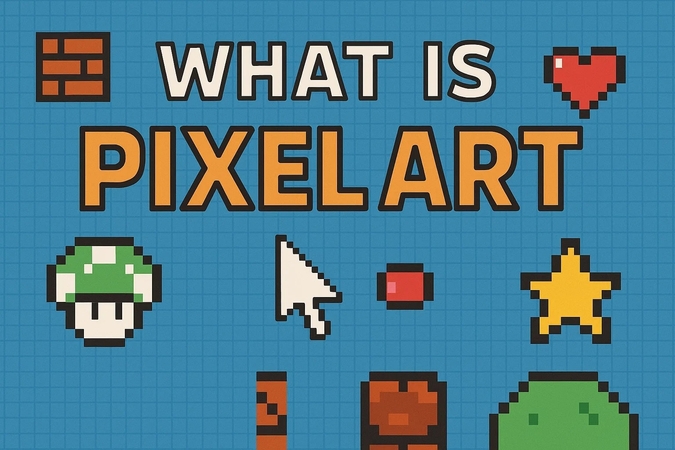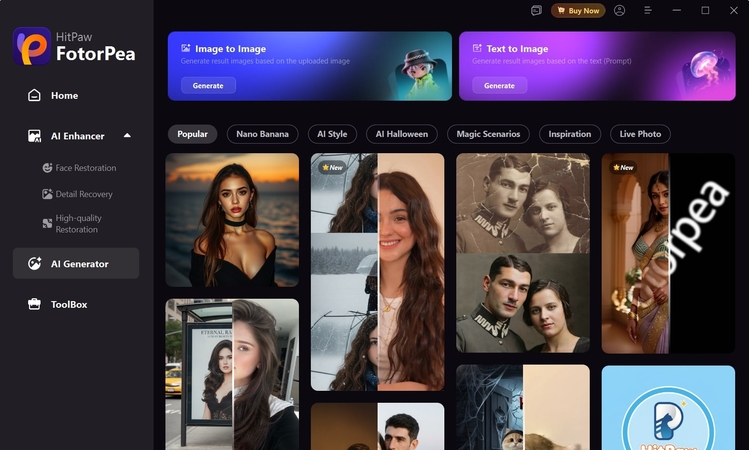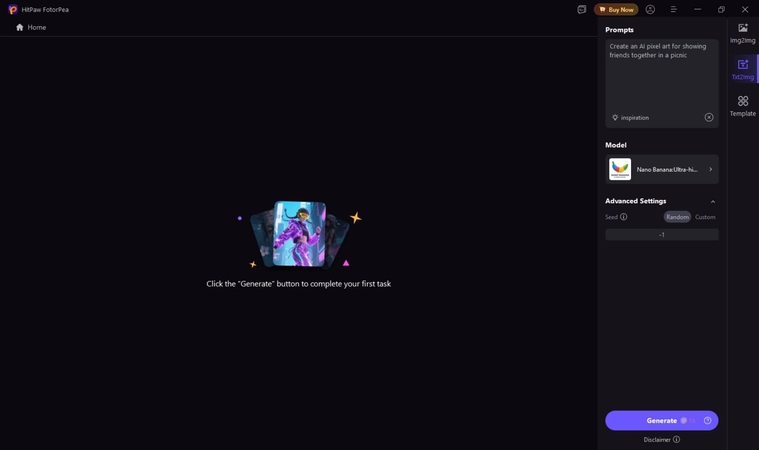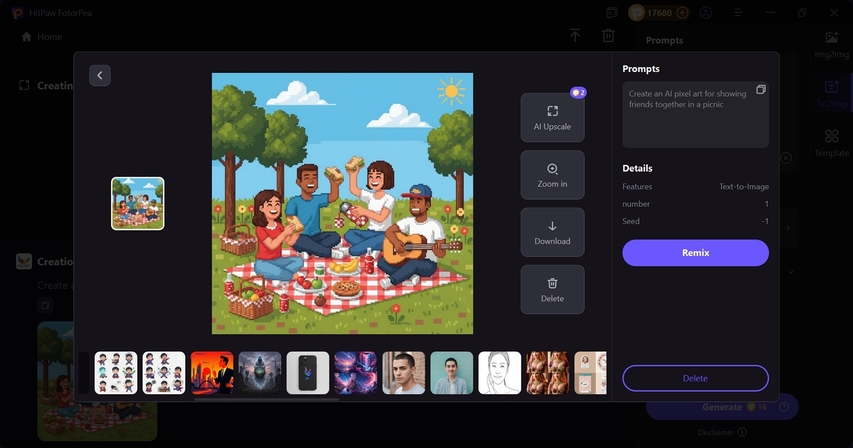How to Tell if Pixel Art Is AI: Simple Visual and Tool Guide
Pixel art has been a product of love. It is designed by artists who individually place each pixel to create retro-style designs and nostalgic game sprites. Nevertheless, this style can now be imitated by AI generators. Understanding how to tell if pixel art is AI will prevent any harm to the artists and guarantee that you are purchasing original art.
Part 1. What is Pixel Art?
Pixel art is a type of digital art in which images are created by designing each pixel individually. Every small square is strategically arranged to create shapes, figures, and elaborate scenes. This style of art was introduced in early video games, when technology was limited and artists had to work with low resolution and maximum accuracy.
Nowadays, AI generators can replicate this nostalgic pixel aesthetic using thousands of examples and advanced algorithms. Although these tools may be able to produce the artwork virtually in seconds, they tend to lack the mindfulness that makes human-made creations feel alive. This has made it increasingly difficult to distinguish between authentic pixel art and AI-generated designs.

Part 2. Why Learning How to Tell if Pixel Art Is AI Matters
The knowledge of how to tell if pixel art is AI relates directly to the problem of copyright and fair use. Selling AI-generated images as original work is a legal and ethical issue concerning ownership and creator rights. Thus, understanding how to identify these differences is a way of safeguarding the interests of all.

Artists: Knowing how to spot AI pixel art protects original creativity and helps real artists get proper recognition.
Game Developers: Identifying AI art ensures legal, ethical asset use and keeps projects free from copyright risks.
Buyers and Collectors: Understanding the difference prevents being misled and supports genuine artistic work.
Buyers and collectors: Knowing how to spot AI-made pixel art prevents overpaying for fakes while ensuring real artists get fair support.
Part 3. How to Spot AI-Generated Pixels: Key Visual Signs
Careful observation can reveal small signs that separate AI pixel art from real human work. Watch closely for these important details when examining any piece of pixel artwork.

- 1. Inconsistent Pixels:One clear sign of how to tell if the pixel art is AI lies in its uneven pixel structure. Some areas look sharp, while others appear random or scattered. Human artists maintain balanced density, ensuring every pixel aligns naturally with surrounding details.
- 2. Blurry or Smeared Edges:AI tools often fail to create sharp outlines. You may notice fuzzy color transitions where clean borders should exist. This blending disrupts the neat, blocky aesthetic of real pixel art that skilled creators achieve through deliberate, precise placement.
- 3. Odd Lighting or Shadows:Lighting flaws are another giveaway in how to tell if pixel art is AI. Highlights might not match object shapes, while shadows fall incorrectly. Human artists plan every light source carefully, producing depth and logical contrast across the artwork.
- 4. Repetitive Patterns:AI-generated textures often reuse identical elements like clouds, bricks, or grass. These patterns appear too uniform and predictable. In contrast, human artists introduce small variations, giving each repeated design a natural and handcrafted rhythm.
- 5. No Visible Artist Touch:AI pixel art looks flawless but lacks warmth and emotion. Genuine artists show personality through color, character, and small imperfections. Understanding these traits helps you spot artificial precision in AI-made pieces easily.
Part 4. How to Identify AI Pixel Art: Texture and Detail Clues
Texture analysis provides a deeper understanding when exploring how to tell if pixel art is AI. By focusing on pixel behavior and surface details, you can spot the differences between authentic artistry and automated precision.
- 1. Smooth Transitions:AI pixel art often blends colors too smoothly, missing the deliberate dithering and crisp edges that define true craftsmanship. Overly soft gradients usually signal algorithmic color handling.
- 2. Color Banding:Uneven color steps or strange tone merging often expose AI involvement. Skilled pixel artists use limited palettes carefully, achieving smoother transitions without producing artificial-looking color bands.
- 3. Texture Placement:Each pixel in handmade art serves a clear purpose. AI distributes details evenly, creating flat, repetitive surfaces that lack material understanding or creative intention.
- 4. Reflections and Depth:Reflections or shadows placed incorrectly suggest machine output. Human artists adjust lighting with care, ensuring consistency between object form, surface type, and visible light direction.
- 5. Excessive Detail:AI tends to overfill pixel spaces, creating cluttered scenes. Human creators favor restraint, balancing simplicity with clarity to maintain the clean structure of traditional pixel art.
Pro Tip: From Recognizing AI Pixel Art to Creating Your Own with HitPaw FotorPea
Once you've learned how to tell if pixel art is AI-generated, you might feel the need to create your own unique outlook. This is where HitPaw FotorPea (formerly HitPaw Photo Enhancer) comes in with its smart AI-generation facility. The service helps turn ideas into stunning visuals using different pixel styles within seconds.
While you spot AI art, you can also become a creator using it with FotorPea. The tool aims to empower both beginners and professionals to generate original pixel artwork. Its main motive is to cast out the extensive training while offering control with style.
Key Features
- 1.Generates unique pixel art from text descriptions instantly within the AI Image Generator.
- 2.Customize style, color palette, and complexity with the AI Photo Editor.
- 3.Transforms photos into retro pixel art automatically within its Image-to-Image model.
- 4.Accesses multiple AI models for diverse artistic outputs.
- 5.Efficiently upscales the quality of images by 8x using the Upscale Model.
How to Create Better Pixel Art with AI Using HitPaw Image Generator
Step 1. Access Text to Image Model Within FotorPea
Launch HitPaw FotorPea and go to the "AI Generator" section on the left. Continue to select the "Generate" option across the "Text to Image" button.

Step 2. Define Prompt Guidelines For Pixel AI Art
Provide the desired prompt to create a pixel AI art according to your desire. Define the "Model" and other "Advanced Settings" before clicking "Generate".

Step 3. Review Results and Download Pixel Art
Once you've obtained your results, click the "Magnifying" icon to view the image in detail. Upon satisfaction, tap the "Download" button to export the results to your device.

FAQs on How to Tell if Pixel Art Is AI
It is possible to add signatures and watermarks across an image with ease. You need to examine the quality, consistency, and intention of adding the signature. The authenticity always comes with deliberate choices, which help you decide whether it is AI.
The copyright laws are not limited to illegal boundaries, as they vary by jurisdiction. Some regions do not grant copyright for AI-generated work. You need to verify local regulations and disclose if the art is AI-created.
To determine how to tell if pixel art is AI, you can check seller history and their portfolio. Customer reviews and in-depth examination for AI indicators like inconsistent pixels or unnatural lighting can be an easy guess.
Conclusion
In the end, learning how to tell if pixel art is AI helps protect creativity and honesty in the art world. By noticing small visual signs and texture differences, you can judge an artwork's true origin with confidence.
Meanwhile, tools like HitPaw FotorPea make it easy to create AI pixel art in an open and transparent way. Understanding these details deepens your respect for both real pixel artists and the innovation that continues to shape digital art today.
Leave a Comment
Create your review for HitPaw articles









